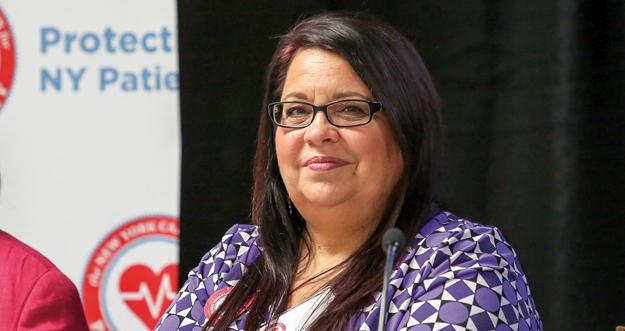NYSNA RNs respond to synthetic drug abuse

Hardly a day goes by without a new report of an overdose of synthetic marijuana (cannabinoids), cathinones like bath salts, or opioids, and NYSNA nurses working hospital emergency rooms from Buffalo to Long Island see the crisis firsthand.
On a single night in July, the Emergency Room staff at NYC Health + Hospitals’ Woodhull Medical Center treated an unprecedented 30 patients who had overdosed on K2, one of the many forms of synthetic marijuana. The professional and compassionate response by the ED’s caregivers garnered special praise from H + H President and CEO Dr. Ram Raju.
Unknown and unpredictable
The contents and effects of K2, Spice and other synthetic cannabinoids and cathinones are unpredictable due to a constantly changing variety of chemicals used in manufacturing and production processes devoid of quality controls or regulatory oversight. The potency of the drugs, and their widespread availability and low price — a package of K2 can be purchased for as little as $5 — have made them increasingly popular among drug users.
At the same time, law enforcement and healthcare providers are facing a large influx of fentanyl, a synthetic opioid long prescribed for severe pain that is 30 to 50 times more powerful than heroin. On the street, heroin is now often combined with fentanyl to increase potency, increasing the risk of overdose.
Here in New York, admissions for heroin and prescription opioid-abuse treatment increased 40 percent over the past decade. In Upstate New York and on Long Island, admissions for opioid and heroin addiction increased 94 and 117 percent respectively. Heroin admissions to OASAS addiction treatment programs rose 35 percent between 2006 and 2015. In May, Governor Cuomo’s launched a statewide heroin task force charged with ending the state’s heroin and opioid crisis.
NYSNA’s Treasurer Pat Kane, a Registered Nurse at Staten Island University Hospital, has become a leader in the fight to address drug addiction on Staten Island, which New York City health officials have identified as the epicenter of the city’s heroin overdose crisis.
Ms. Kane became involved in addressing the problem five years ago through community outreach work fighting the closure of Bayley Seton’s detox beds. “We knew detox beds were already in short supply and that we couldn’t afford to lose any more,” said Ms. Kane.
Then Hurricane Sandy hit. “Most NYSNA nurses are hospital-based, and unless you work in the ED, you’re somewhat insulated from what’s happening on the streets. Our union’s work in helping Staten Island respond and recover from Hurricane Sandy put us out in the community in ways that many of us had not been in the past. It certainly opened my eyes to the rising street drug epidemic.”
Filling the Void
Staten Island is the only city borough without a public hospital. “There’s tremendous need and no public health system to meet it,” said Ms. Kane. Organizations like Community Health Action Staten Island (CHASI) and Tackling Youth Substance Abuse (TYSA) try to fill the void, but they can’t do it alone. “My NYSNA colleagues and I couldn’t help but be drawn into the tremendous work these community groups were doing. That’s how we were introduced to the Staten Island Sisterhood, a coalition of the island’s volunteer women’s groups concerned with the welfare of women and families. It’s the silver lining that came out of the whole Sandy experience.”
When Ms. Kane was asked to serve as the Sisterhood’s 2016 chair, she, in turn, asked that member organizations focus this year’s efforts on substance abuse. “We worked closely with TYSA to put together a ‘train the trainer’ workshop specific to Staten Island. In February, NYSNA with our Sisterhood partners held a ‘Staten Island Parents: You Matter!’ workshop to give parents and caregivers the tools they need to start the conversation with young people on the dangers of drugs.”
Once school resumes in September, Ms. Kane and her Sisterhood partners will plan another workshop for parents. The clock is ticking. The Sisterhood’s rotating leadership chair passes to another group in a few months, and the need for raising community awareness and connecting those in need with the appropriate resources is unending.
Through NYSNA, Ms. Kane is working with the Governor’s Opioid Task Force to increase the number of detox beds and other related resources and better prepare Staten Island’s healthcare providers and families for dealing with whatever the future may hold. She, too, has high praise for Woodhull’s ED staff: “Their ability to respond to 30 overdoses in a single night is really remarkable. With the resource cuts of recent years, I’m not sure if any of the hospitals in Staten Island could have handled it quite so well.”
Ms. Kane is committed to reversing those trends. “NYSNA and our partners will keep advocating until our Staten Island patients have access to the same level of exceptional response.”